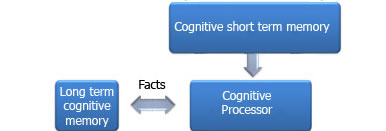6. Cognitive Processor

Once the fusion of information is combined in short term cognitive memory, it then feeds the cognitive processor. The cognitive processor takes another information feed from your long term cognitive memory and tries to combine the two streams to form a full understanding of what is happening at that instant.
If the effort warrants it, then the new information is also stored back into long term memory.
For example, you come across a slightly novel interface, it has many parts you already understand (which were retrieved from long term memory) but it also has a few novel items as well - perhaps a 'colour picker' or a different type of calendar. After processing this new information so you understand it, you then decide that this is worth remembering for next time..
This is why creating a well understood interface is very efficient - the person has to do little new processing to understand what needs to be done. At the other extreme, if you know absolutely nothing about this new interface you will have to work (process) much harder and hence slower. It is likely errors will be made as well.
A good measure of this processing effort is your reaction time to an event in the interface. For example, the time it takes you to click on the 'ok' button in an alert.
challenge see if you can find out one extra fact on this topic that we haven't already told you
Click on this link: HCI and attention span
